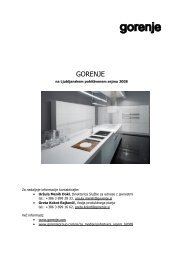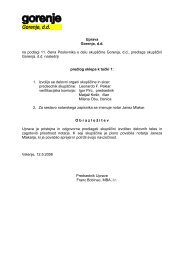ANNUAL REPORT 2008 - Gorenje Group
ANNUAL REPORT 2008 - Gorenje Group
ANNUAL REPORT 2008 - Gorenje Group
Create successful ePaper yourself
Turn your PDF publications into a flip-book with our unique Google optimized e-Paper software.
94<br />
<strong>2008</strong><br />
that are expected to be applied to the temporary differences when they reverse, based on the laws<br />
that have been enacted or substantively enacted by the reporting date. Deferred tax assets and liabilities<br />
are offset if there is a legally enforceable right to offset current tax liabilities and assets, and<br />
they relate to income taxes levied by the same tax authority on the same taxable entity, or on different<br />
tax entities, but they intend to settle current tax liabilities and assets on a net basis or their<br />
tax assets and liabilities will be realised simultaneously.<br />
A deferred tax asset is recognised to the extent that it is probable that future taxable profits will be<br />
available against which the temporary difference can be utilised. Deferred tax assets are reviewed<br />
at each reporting date and are reduced to the extent that it is no longer probable that the related<br />
tax benefit will be realised.<br />
(r) Earnings per share (EPS)<br />
The <strong>Group</strong> presents basic earnings per share (EPS) data for its ordinary shares, which is the same<br />
as diluted EPS, because the <strong>Group</strong> has not issued any preference shares or convertible notes. Basic<br />
EPS is calculated by dividing the profit or loss attributable to ordinary shareholders by the weighted<br />
average number of ordinary shares outstanding during the period.<br />
( s ) C o m p a r a t i v e i n f o r m a t i o n<br />
Comparative information has been mainly harmonised with the presentation of information in the<br />
current year. Where required, adjustment of comparative data was carried out in order to comply<br />
with the presentation of information in the current year.<br />
( t ) S e g m e n t r e p o r t i n g<br />
A segment is a distinguishable component of the <strong>Group</strong> that is engaged either in providing related<br />
products or services (business segment), or in providing products or services within a particular<br />
economic environment (geographical segment), which is subject to risks and returns that are different<br />
from those of other segments. Segment information is presented in respect of the <strong>Group</strong>’s<br />
business and geographical segments. The <strong>Group</strong>’s primary format for segment reporting is based<br />
on business segments. The business segments are determined based on the <strong>Group</strong>’s management<br />
and internal reporting structure.<br />
Inter-segment pricing is determined on an arm’s length basis.<br />
Segment results, assets and liabilities include items directly attributable to a segment as well as<br />
those that can be allocated on a reasonable basis. Unallocated items comprise mainly investments<br />
(other than investment property) and related revenue, loans and borrowings and related expenses,<br />
corporate assets (primarily the Company’s headquarters) and head office expenses, and income<br />
tax assets and liabilities.<br />
Segment capital expenditure is the total cost incurred during the period to acquire property, plant<br />
and equipment, and intangible assets other than goodwill.<br />
(u) New standards and interpretations not yet adopted<br />
A number of new standards, amendments to standards and interpretations are not yet effective for<br />
the year ended 31 December <strong>2008</strong>, and have not been applied in preparing these consolidated financial<br />
statements:<br />
• IFRS 8 Operating Segments (effective as from 1 January 2009) introduces the<br />
“management approach” to segment reporting. IFRS 8, which becomes mandatory<br />
for the <strong>Group</strong>’s 2009 financial statements, will require the disclosure of<br />
segment information based on the internal reports regularly reviewed by the<br />
<strong>Group</strong>’s Chief Operating Decision Maker in order to assess each segment’s performance<br />
and to allocate resources to them.<br />
Currently the <strong>Group</strong> presents segment information in respect of its business and<br />
geographical segments (see note 43 and 44).

















